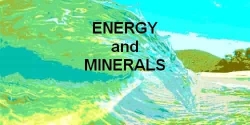Oil Deposits
Oil Deposits

Oil is a general term for a range of liquid hydrocarbons that includes crude oil and condensate:
- Crude oil is a naturally-occurring liquid consisting mainly of hydrocarbons derived from the thermal and chemical alteration of organic matter buried in sedimentary basins. It is formed as organic-rich rocks are buried and heated over geological time.
- Condensate is a liquid mixture of pentane and heavier hydrocarbons found in oil fields with associated gas or in gas fields. It is a gas in the subsurface reservoir, but condenses to form a liquid when produced and brought to the surface.
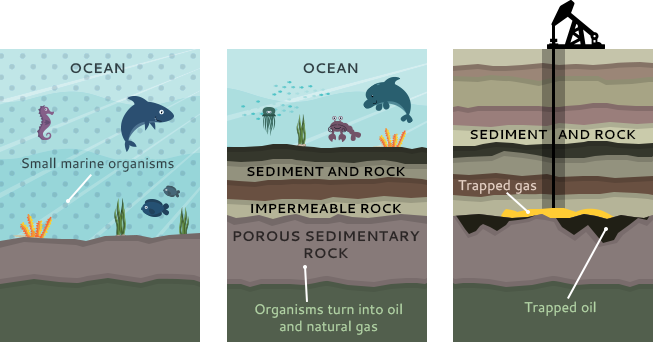
Research has traced the origin of oil to the lipids (oils) of planktonic (free floating) plants and animals which live in brackish water such as blue-green algaes and foraminifera. The brackishness is essential because aerobic bacteria does not live in brackish water which in turn would decompose all of the organic matter. In brackish water the organic matter of the planktonic plants and animals sinks to the bottom and incorporated into clay sediments which ultimately become sedimentary rocks, as we called shale rock. Under high pressure and temperature the oil of clay shales can be squeezed out and into porous rock. In porous rock the oil can travel, until it reaches an impervious barrier such as a salt dome.
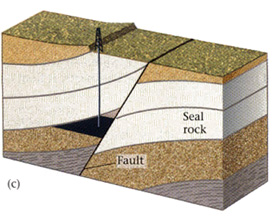
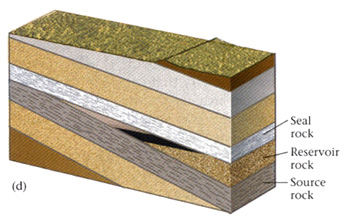
Fault trap Stratigraphic trap
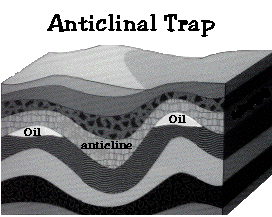

Is oil of inorganic or abiotic origin?
Inorganic Origin
** favoured at one time by the RussiansStates that hydrogen and carbon came together under great temperature and pressure, far below the earth’s surface and formed oil and gas where chemical reactions have occurred.
The oil and gas then seeped through porous rock to deposit in various natural underground traps.It has also excluded the hypothesis that petroleum is a finite substance. There are some different theories that describe the inorganic origin of petroleum which include:
Metal carbide theory
Developed by a Russian chemist and states that the deposition of petroleum is controlled by tectonic activities that occurred during the life of sedimentary rock.
To explain his observations, he has put forth "metal carbide theory". Metal carbides deep in Earth reacted with water at high pressure and temperature to form acetylene which condenses to heavier hydrocarbons.
Reaction equation is: Cac2+H2O= C2H2+Ca(OH)2
Volcanic theory
*Involves outgassing of the mantle via volcanic activity or eruption.
Earthquake theory
Involves outgassing deep Earth's mantle via tectonic activities such as faults, and this is still happening till now.
Serpentinization theory
States that hydrocarbon is a by-product that came from a metamorphic transformation of the green dark Olivine mineral ,which was found in Earth's mantle
Geographical location:
most of hydrocarbon producing regions are located close to belts of tectonic activities.
Stability with depth:
Corresponding to what organic theory's supporters have admitted themselves; petroleum is a fossil fuel, and there has never been a real fossil found below 16000 feet. Nowadays, there is drilling for oil reservoirs at 28000 feet or 30000 feet where there is no a fossil remains.
Organic origin
**at one time favoured by the UK and USAIt is the most widely accepted. The oil and gas are formed from remains of prehistoric plants and animals. Remains of plants have been transformed to coal and animals to oil and gas.
These remains were settled into seas and accumulated at the ocean floor and buried under several kilometers of sediments.
Over a few milion years, the layers of the organic material were compressed under the weight of the sediments above them. The increase in pressure and temperature with the absence of oxygen changed the mud, sand, slit or sediments into rock and organic matter into Kerogen.
After further burial and heating, the kerogen transformed via cracking into petroleum and natural gas.
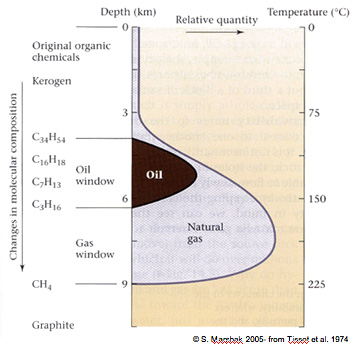
Evidence for organic origin of petroleum
Presence of brine (sea water) with petroleum.Petroleum is found only in association with sedimentary rocks. There is no petroleum associated with igneous or metamorphic rocks.
Polarized light passing through all petroleum resources undergoes a rotation that is similar to all organic oils.
Molecules in hydrocarbons are thought to be similar to that of the organic matter.
The organic carbon found in plants is depleted into C13 due to photosynthesis process.In dead organic matter, it is further depleted due to radioactive decaying.
The same depletion was found in petroleum and natural gas
Australia has about 0.3 per cent of the world oil reserves. Most of Australia’s known remaining oil resources are condensate and liquefied petroleum gas (LPG) associated with giant offshore gas fields in the Browse, Carnarvon and Bonaparte basins. In addition oil resources are identified in the Perth, Canning, Amadeus, Cooper/Eromanga, Bowen/Surat, Otway, Bass and Gippsland basins.

